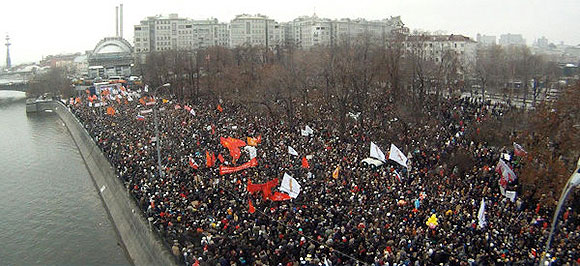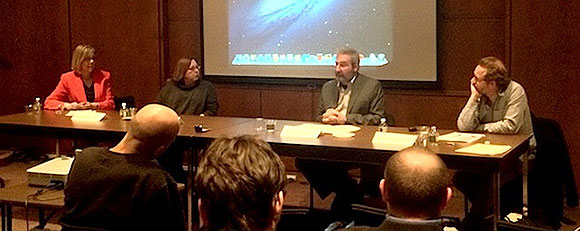Recent protests in Russia have been studied by scholars from the time they began in December 2011. In the last two weeks, the Harriman Institute held two discussion panels, at which US experts shared their thoughts about the prospects for Russia’s opposition movement.

The wave of mass protests in Russia that began in December 2011 evokes a great deal of interest in the academic community. A year after the protests started, a group of American scholars presented the preliminary results of their research into this phenomenon. On January 31st, protests in Russia were discussed at Columbia University’s Harriman Institute: the panel included Graeme B. Robertson (University of North Carolina at Chapel Hill), Regina Smyth (Indiana University, and Mark R. Beissinger (Princeton University).
Regina Smyth’s research focused on the dual-state model in Russia and was, in essence, a comparative study of two types of mass rallies: the anti-Putin and the pro-Putin ones. The goal was to illustrate the structure of social dialogue (or rather the lack of it) in today’s Russia. She described Vladimir Putin’s supporters as “the silent majority,” with social characteristics such as “regional base,” “workers,” “normal people” (a quote from Putin’s speech), who have “a national cultural appeal.” The anti-Putin protesters were referred to as the “radical minority,” and some of the attributes describing them included “urban or creative class,” “disloyal,” “revolutionary,” and “under foreign influence.” Both sides had few concrete demands (in contrast with the rallies of the early 1990s)—their protest was mostly symbolical.
As Smyth pointed out, the street protests reflected the national debate about the nature of the regime. Interestingly enough, according to her observations, both sides—anti-Putin and pro-Putin—said they cared about corruption in the country, but anti-Putin protesters blamed the current president for the devastating state of affairs, while the other side proclaimed their trust in him. The two groups also differed in their dedication: the core of pro-government rallies was only 20 percent of the total number of participants (many came out only once, some were paid to participate;) while the core of anti-government protests reached 60 percent.
Both sides—anti-Putin and pro-Putin—said they cared about corruption in the country.
Graeme Robertson discussed three myths that exist with regard to the protests. The first myth is that during these protests, “Russia woke up.” In reality, he argued, the reason for the public outburst was a combination of various long-term trends and factors. “The [protesters’] repertoire has become more symbolic; their demands, more general; the locations, more metropolitan.” The second myth is that protests were caused by post-election disillusionment. As Robertson noted, this is only partly true, since the protesters’ expectations were low to begin with. “Almost 80 percent of the creative class thought that Putin was going to win,” he said. “Protesters were neither optimistic, nor disillusioned—no one was getting too excited. Russia is a sort of post-optimistic society.” The third myth mentioned by Robertson was that “Moscow is another planet” and is different from the rest of Russia. As he pointed out, this myth was created by Putin’s propaganda, but the polls clearly show that educated people in the regions are not that different from Muscovites in terms of their assessment of the political situation and their attitudes to the regime.
Mark Beissinger, concluding the discussion, noted that the “snow revolution” highlighted a number of ongoing social trends. “Civil activism [in Russia] used to be quite low, as was mutual trust. After the ‘snow revolution’ the situation has changed. We are seeing an incredible growth in volunteer work. Public sphere has expanded due to the Internet, and developments in the virtual civil society are absolutely critical for the protest movement,” he emphasized. Beissinger pointed to some of the shortcomings of the protest movement, such as its organizational weakness, a lack of strategy in fighting the regime and a lack of commitment to a long-term struggle.

Another panel entitled “The Fate of Protest in Russia” was held on February 11th. Among the panelists were Svetlana Reiter (the 2013 Klebnikov Russian Civil Society Fellow, special correspondent at Esquire Russia, and correspondent at Bolshoi Gorod), Ann Cooper (Columbia Journalism School), Janet E. Johnson (Brooklyn College), and William Partlett (Columbia Law School.) Cooper reviewed the history of harshly repressed protests in the Soviet Union, mentioning the 1962 Novocherkassk massacre, during which 26 protesters were killed; and the 1968 Red Square demonstration against the Soviet invasion of Czechoslovakia that ended in the arrest of the seven protesters.
Svetlana Reiter recalled a rumor that, after he won the presidential election, Putin said that since these people (the protesters) wanted to ruin his celebration, he would ruin their lives. Since then, a large number of criminal cases have been opened against opposition activists. The “Bolotnaya Square Case,” little known outside Russia, involves 19 people who were arrested following the May 6th, 2012, March of Millions and were accused of violence against the police.
Putin borrowed one of his key principles from former Peruvian dictator Oscar Benavides—“For my friends, anything, for my enemies, the law.”
William Partlett spoke about the selective use of law in Russia. He recalled that Putin came to power with an agenda of fighting corruption and pursuing legal reform, but he used it against his opponents. According to Partlett, Putin borrowed one of his key principles from former Peruvian dictator Oscar Benavides—“For my friends, anything, for my enemies, the law.” “Putin used this principle when he was taming governors, oligarchs, and the opposition. We have a number of cases that illustrate his way of resolving problems—the Khodorkovsky case, the Magnitsky case, the Pussy Riot case, and the latest case of Sergei Udaltsov,” Partlett continued. “These are showcases aimed at silencing the opposition.”
Janet Johnson shared her views of the feminist movement in Russia, reminding the audience that that it was the regime that started the gender competition by toying with the image of a strong “masculine” leader. “Vladimir Putin would appear in the news flying the jet, saving the snow tiger, riding the horse displaying a naked torso, and so on. The idea of this propaganda was to sex up Putin’s image, to make it more attractive and then to politicize it in favor of the regime,” she explained. “It was inevitable that this macho image would get a rival feminist response. This response was channeled through Pussy Riot’s provocative performances, and, for some reason, Putin seemed to take this message personally.” Consequently, members of the band were arrested and convicted.
Experts agreed that the first wave of mass protests in Russia is over, and a more structured and thought-through struggle is beginning. Much will depend on the way opposition leaders strategize and build up their work in fighting the regime.

